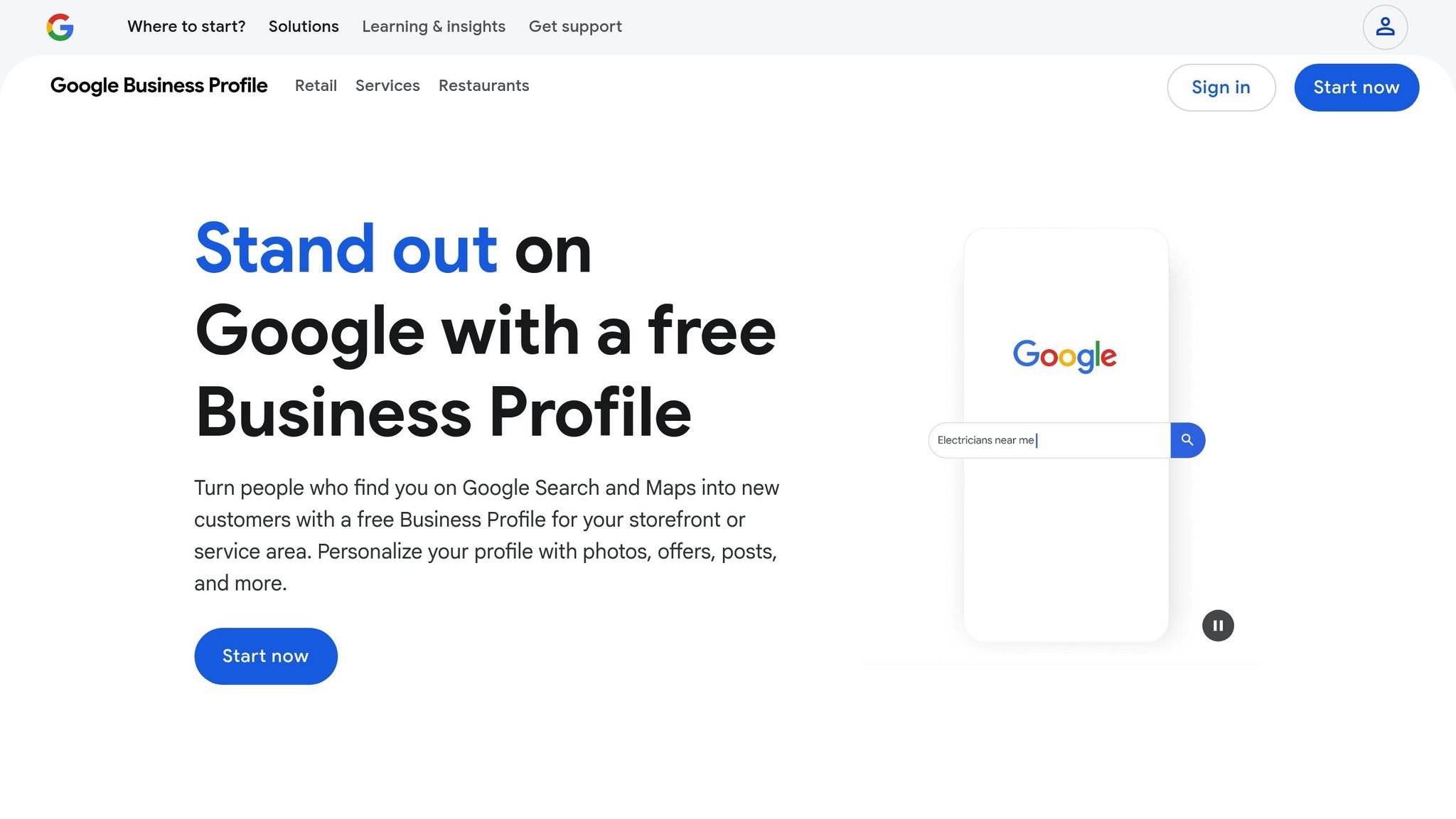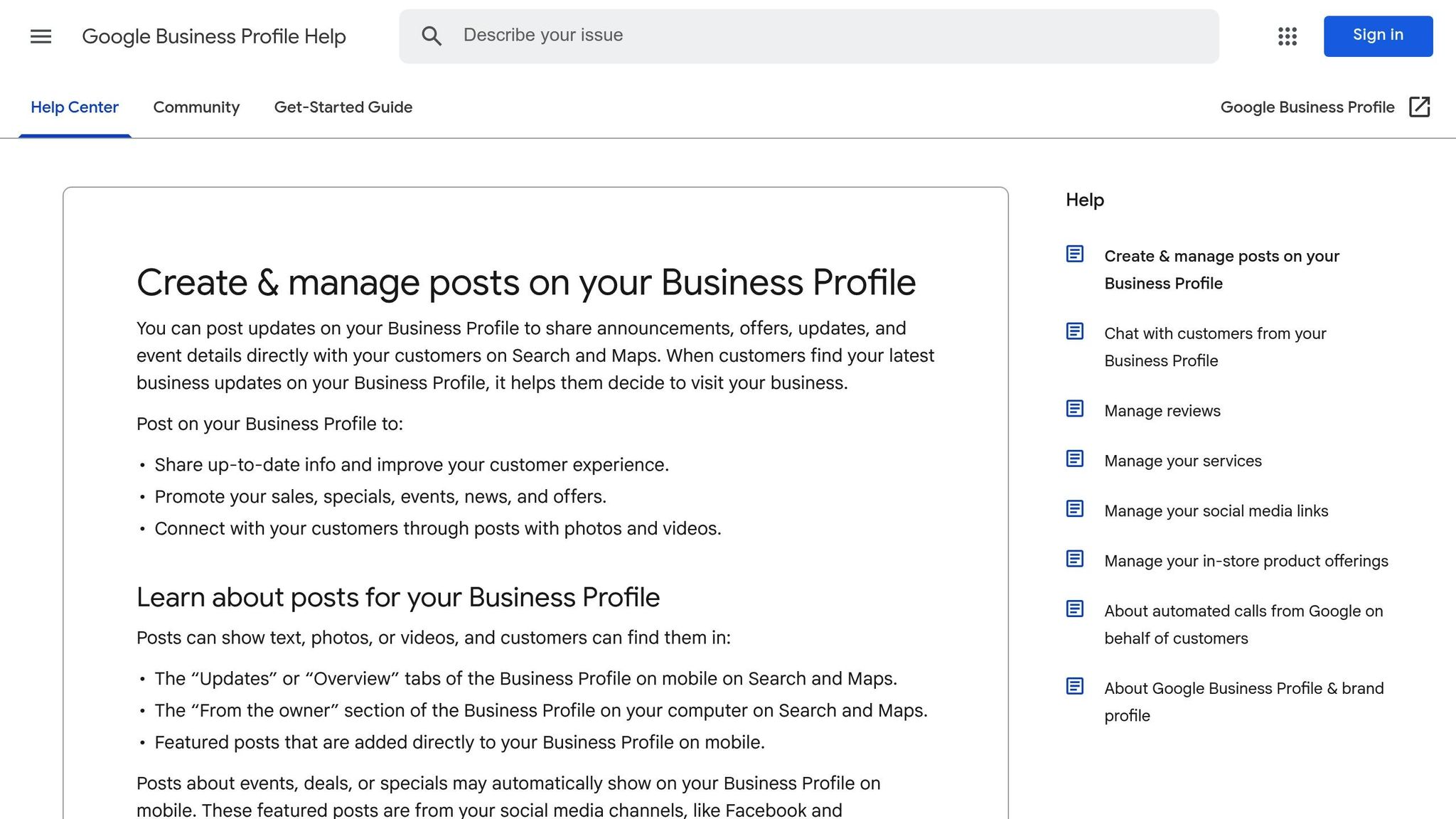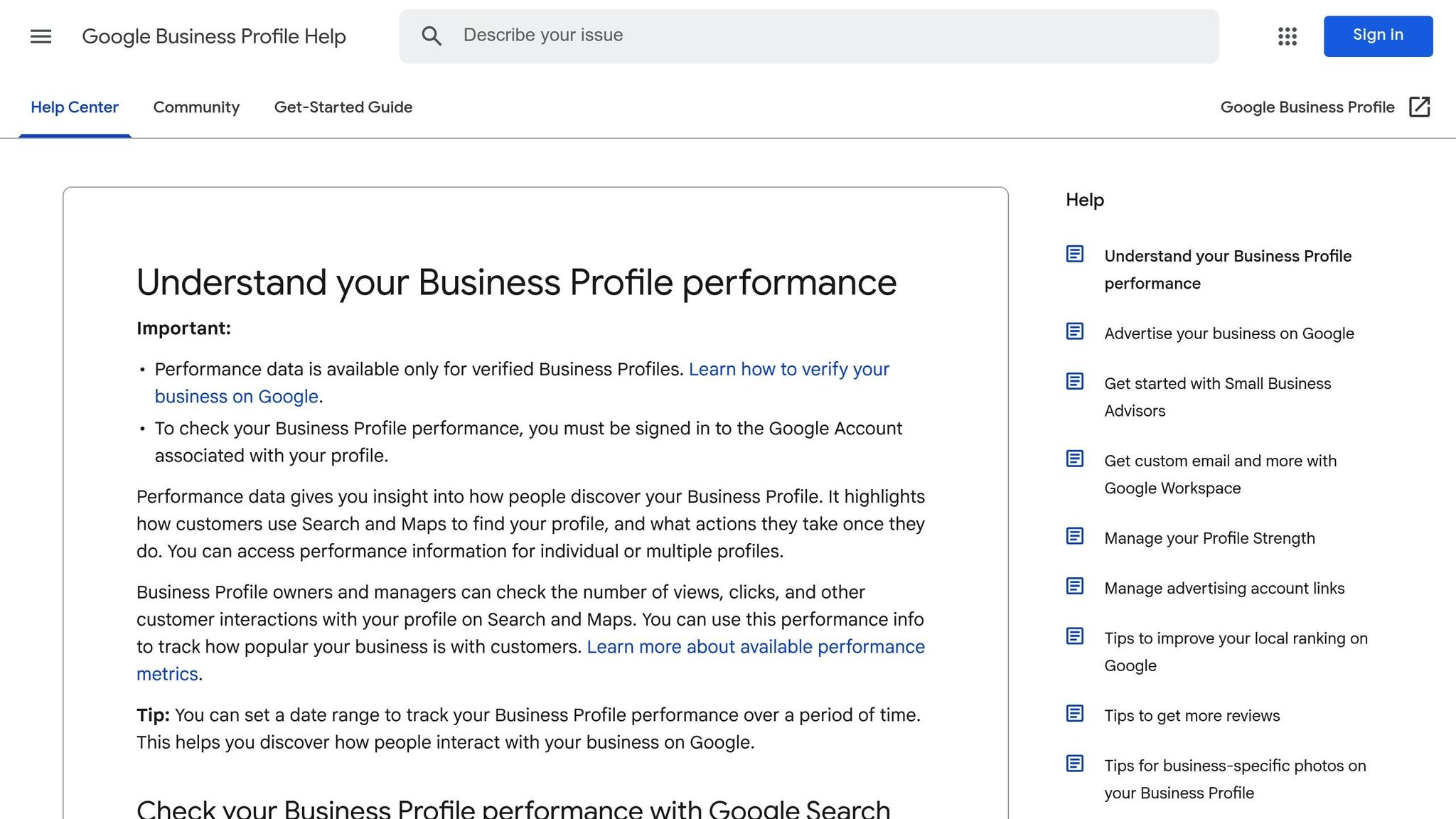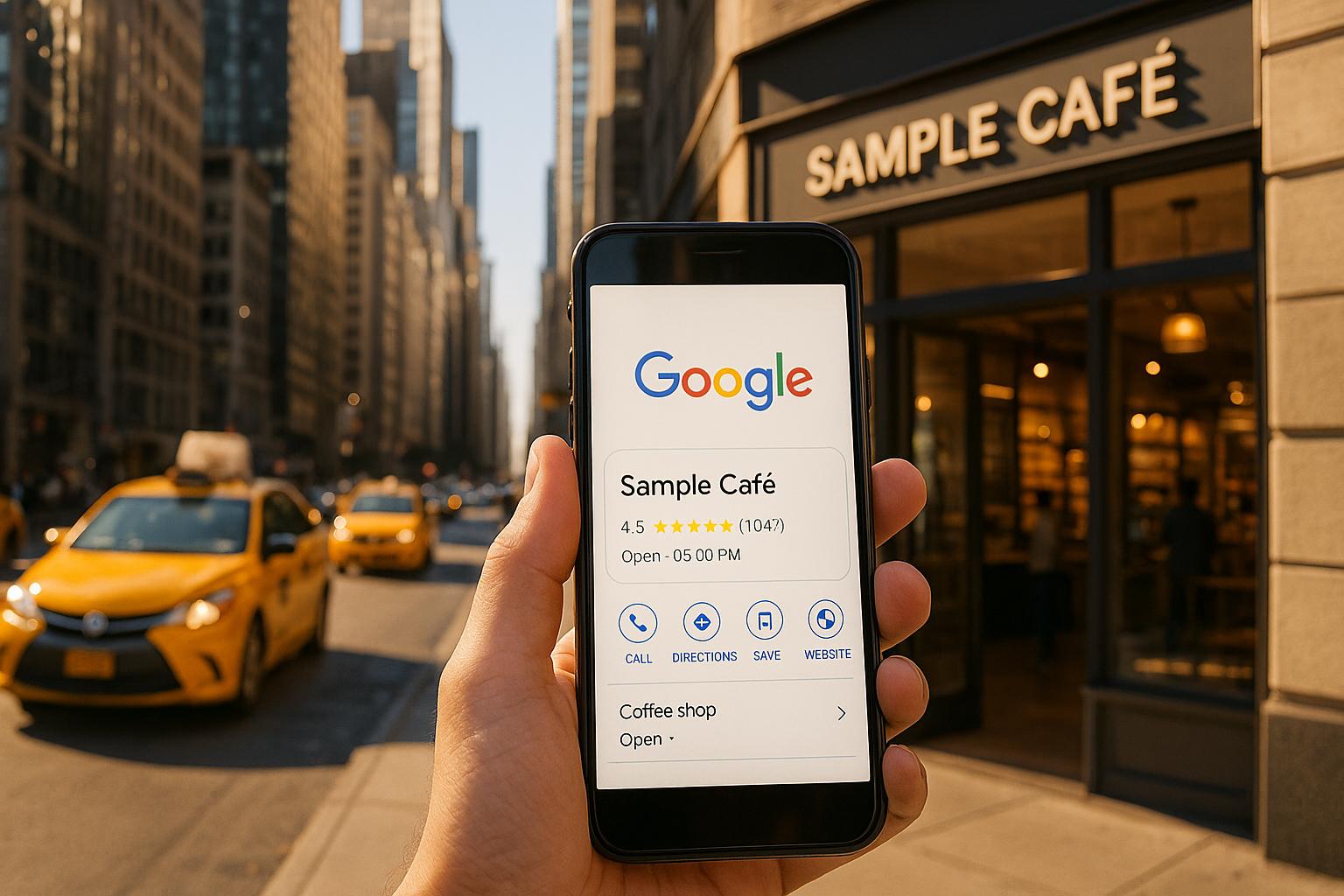Want more customers in NYC? Start with your Google Business Profile. In a city as competitive as New York, your profile is often the first thing people see when searching for businesses like yours. Optimizing it can help you:
- Appear in the "Local Pack" (top 3 listings on Google Maps).
- Attract more foot traffic and calls from high-intent searches like "pizza near me" or "plumber in Brooklyn."
- Build trust with accurate info, photos, and reviews.
Here’s how to make it work for you:
- Keep details accurate: Ensure your name, address, and phone number (NAP) are consistent everywhere.
- Use local keywords: Mention neighborhoods, landmarks, or services like "coffee near Central Park."
- Add photos: High-quality images of your storefront, products, and team grab attention.
- Encourage reviews: Respond to every review – positive or negative – to show you care.
- Post regularly: Share updates, events, or promotions to stay visible.
Bottom line: An optimized profile makes your business easy to find and trustworthy – key factors for standing out in NYC’s crowded market.
How To Optimize A Google Business Profile (Free Checklist For 2025)

How to Set Up and Optimize Your Google Business Profile
Setting up and fine-tuning your Google Business Profile is like giving your NYC business a 24/7 digital storefront. These steps will help you turn your profile into a tool that attracts and engages customers effortlessly.
Keep Your Business Information Complete and Accurate
Start by ensuring your business details – Name, Address, and Phone Number (NAP) – are consistent across your website, social media, and other directories. Even small inconsistencies like using "St." instead of "Street" can hurt your local search rankings. Consistency not only improves your search visibility but also builds trust with potential customers.
Make sure your business hours are accurate and updated. Few things frustrate customers more than showing up to a closed door when your profile says you’re open.
Choose a primary category that best describes your business. Then, add secondary categories to reflect additional services. For example, a Brooklyn pizza shop might list "Pizza Restaurant" as its main category, while including "Italian Restaurant" and "Takeout Restaurant" as secondary options.
When writing your business description, focus on what sets you apart. Skip vague claims like "best service in NYC" and instead highlight specific details. For instance: "Family-owned Italian restaurant serving handmade pasta since 1985" or "24-hour locksmith offering 15-minute response times in Manhattan and Brooklyn."
Add High-Quality Photos to Show Your Business
A picture is worth a thousand words – and on your Google Business Profile, it can be worth a thousand clicks. High-quality photos help build trust and encourage engagement.
Start with a clear, well-lit photo of your storefront during business hours. This helps customers recognize your location when they visit. Next, upload pictures of your interior, products, and team. These images bring your business to life and make it more relatable.
Keep your profile fresh by adding new photos regularly. Google rewards active profiles, and updated images show potential customers that your business is engaged and current. Seasonal photos can add a nice touch, like outdoor seating in the summer or festive holiday decorations in the winter.
Write a Business Description with Local Keywords
Your business description is your chance to shine, so make it count. Write a concise description (up to 750 characters) that naturally includes local keywords, specific services, and what makes your business stand out.
For example, instead of saying, "Best Italian food in NYC", go for something like: "Family-owned Italian restaurant in SoHo, serving handmade pasta since 1985." Include your neighborhood or borough naturally: "Located in the heart of SoHo, our boutique offers handcrafted jewelry and accessories to Manhattan fashion enthusiasts."
Mention the specific services or products you offer. For instance, a dental practice might highlight "teeth whitening, dental implants, and emergency dental care", while a marketing agency could list "social media management, website design, and Google Ads campaigns." These details help Google connect your profile to relevant searches.
Don’t forget to highlight what makes you different. Maybe you offer same-day delivery in Manhattan, speak multiple languages, or have extended weekend hours. These unique features can be the deciding factor for customers choosing your business.
Write in a friendly, conversational tone – like you’re recommending your business to a friend. Avoid technical jargon unless it’s something your customers are familiar with and actively search for. Keep it simple, engaging, and customer-focused.
Local SEO Strategies for NYC Companies
Standing out in NYC’s bustling market means making your local SEO a priority. One of the most effective ways to boost visibility is by integrating your Google Business Profile into your strategy. In a city where people are constantly searching for things like "pizza near Times Square" or "dentist in Williamsburg", dialing in on the right local keywords can make all the difference. To go even further, align your keywords and content with NYC’s diverse neighborhoods for a more targeted approach.
Use Targeted Local Keywords
The key to local SEO success is adopting the exact phrases your customers use when searching. Location-specific searches like "coffee shop near Penn Station" or "best espresso in SoHo" are goldmines for connecting with high-intent customers.
Start by narrowing down the neighborhoods, landmarks, and areas your business serves. For example, if you’re a plumber in Queens, avoid generic keywords like "plumber NYC." Instead, use phrases like "emergency plumber Astoria", "plumber near LaGuardia Airport", or "Queens residential plumbing services." These specific terms not only reduce competition but also attract customers actively looking for services in your area.
NYC’s neighborhood pride is strong, so neighborhood-specific keywords resonate particularly well. A bakery in Park Slope, for instance, could focus on terms like "Park Slope bakery", "Brooklyn artisan bread", or "organic pastries near Prospect Park." These phrases reflect how locals think and search for businesses.
Landmark-based searches are another powerful tool. Both New Yorkers and tourists often use iconic locations as reference points. A restaurant near Central Park might optimize for "dinner near Central Park", while a Midtown hotel could target "hotel near Broadway theaters" or "accommodation near Times Square."
Don’t overlook transit-focused keywords, either. In a city where public transportation is central to daily life, people frequently search for businesses near subway stops, bus routes, and major hubs. Phrases like "coffee near Union Square station", "lunch delivery to Financial District", or "parking near Madison Square Garden" can help you capture these transit-oriented customers.
Incorporate these keywords naturally into your business descriptions, services, and posts to strengthen your local SEO while keeping your content engaging and conversational.
Create Google Posts to Reach Local Customers

Beyond keywords, active posting on Google can significantly boost your visibility and engagement. Google Posts transform your business profile into a dynamic feed that appears directly in search results, helping you share timely updates and connect with customers when they’re ready to take action.
Event posts are especially effective in NYC, where there’s always something happening. A Brooklyn rooftop bar might post a quick video showcasing its skyline views to draw in customers. Restaurants can highlight happy hour deals, retail shops can promote flash sales, and service businesses can share limited-time offers.
Seasonal content also strikes a chord with New Yorkers, who experience the city differently throughout the year. A fitness studio could promote outdoor boot camps in Central Park during spring, while a boutique might showcase its winter coat collection as the temperatures drop.
You can also tie your posts to local events to tap into the city’s vibrant energy. For example, during Yankees games, sports bars could highlight game-day specials. During Fashion Week, salons might showcase services tailored for the occasion. From street festivals to concerts, there’s no shortage of opportunities to create timely, engaging content that resonates with your audience.
For maximum impact, ensure your posts are visually appealing and mobile-friendly. Most people will view them on their phones while navigating the city. Use high-quality images, concise text that’s easy to read on small screens, and clear calls-to-action like "Visit us today" or "Call now for same-day service."
Consistency is key when it comes to posting. Aim to post once or twice a week rather than flooding your profile for a month and then going quiet. Google rewards active profiles, and regular updates keep your business top-of-mind for local customers. If you’re short on time, consider batching your content in advance to stay consistent.
Lastly, highlight local collaborations in your posts. Partnering with other NYC businesses not only builds credibility but also fosters a sense of community. A coffee shop could share that it sources beans from a local roaster, while a boutique might feature products from NYC designers. These connections show you’re deeply rooted in the local business ecosystem, which resonates with customers who value supporting local enterprises.
How to Manage Customer Reviews to Build Trust and Improve Rankings
Customer reviews play a major role in local search success in NYC. With 73% of all online reviews happening on Google, they influence not only your search rankings but also customer decisions. When someone in Manhattan, Brooklyn, or elsewhere in the city searches for a business, they’re not just checking your star rating – they’re reading what other locals have to say about your service.
Here’s the reality: 93% of consumers expect businesses to respond to their reviews, and 41% are more likely to choose businesses that do. In a city overflowing with options, how you handle reviews can make or break your visibility and reputation. Reviews don’t just drive rankings – they build trust. Actively encouraging and managing them is essential.
Get Customers to Leave Reviews
Encouraging happy customers to leave reviews requires a thoughtful approach – one that feels natural, not forced. Did you know that 69% of customers will leave a review if asked? The trick lies in timing and delivery.
Ask at the right moment. The best time to request a review is immediately after a positive interaction – whether it’s after excellent service, a successful transaction, or a compliment from the customer. For example, a Brooklyn restaurant might ask diners who rave about their meal to share their thoughts online.
Make it part of your routine. Train your staff to casually mention reviews during positive moments. A simple line like, "If you enjoyed your visit, we’d love it if you could share your experience on Google", feels natural and genuine. It’s much more effective than a generic email sent weeks later.
Follow up with a personal touch. Sending a thank-you email within 24–48 hours of a service or purchase works well. Include a direct link to your Google Business Profile to make leaving a review effortless. The easier the process, the more likely customers are to follow through.
Use tasteful in-store signage. For retail stores and restaurants, a small sign near the checkout or exit can be effective. Something like, "Loved your experience? Let other New Yorkers know on Google!" can catch customers while their positive experience is fresh.
Keep it mobile-friendly. In a city where everyone’s glued to their phones, ensure your review links work seamlessly on mobile devices. A QR code that leads directly to your Google review page is a quick and convenient option.
Avoid offering incentives. It might be tempting, but Google prohibits offering discounts or freebies in exchange for reviews. Violating this rule can hurt your rankings and credibility. Stick to authentic, honest reviews.
Respond to Reviews to Build Customer Loyalty
Once you’ve gathered reviews, responding to them effectively strengthens your reputation. Thoughtful, timely responses not only address customer concerns but also improve your visibility and credibility. 54% of customers who leave a negative review expect a response, and how you handle it can influence countless others who read your reply.
Respond to every review – good or bad. Each response is a chance to show potential customers that you value feedback and are committed to quality service.
Make your replies personal. For positive reviews, thank the customer specifically. For instance, a Midtown salon might say, "Thank you, Sarah! We’re thrilled you loved your new haircut, and we’ll be sure to let Maria know how happy you are. We can’t wait to see you again!"
Handle negative reviews calmly and professionally. Avoid defensive responses. Instead, acknowledge their concerns, apologize if necessary, and offer to resolve the issue. A Queens auto repair shop might respond: "We’re sorry your oil change took longer than expected, Mike. We had unexpected staffing issues that day, but we’d love the chance to make it up to you. Please call us at (718) 555-0123 so we can discuss how to make things right."
Keep responses concise and personalized. Aim for 2–3 sentences that directly address the review. Long, automated replies can feel impersonal and may turn readers away.
Act quickly. While you don’t need to respond instantly, replying within a few days shows you’re engaged and attentive. This responsiveness signals to both Google and potential customers that you care about your reputation.
Showcase your brand’s personality. Your responses give potential customers a glimpse into your business culture. A Brooklyn bookstore might use a touch of humor, while a Financial District law firm would maintain a more formal tone. Stay professional but true to your brand.
Handle complex issues privately. If a customer has a detailed complaint, acknowledge it publicly first, then invite them to continue the conversation via phone or email. This approach shows others that you take concerns seriously while respecting privacy.
Track Performance and Connect with Your Local SEO Strategy
Keeping your Google Business Profile in top shape demands consistent effort – especially in NYC, where competition is fierce. Regularly tracking your profile’s performance and tying it into your overall local SEO strategy can uncover opportunities to fine-tune your approach. A great place to start? Dive into Google Insights for data you can act on.
Use Google Insights to Monitor Performance

Google Insights is a treasure trove of data about how customers discover and interact with your business. It breaks down whether visitors found you through direct, discovery, or branded searches and tracks actions like profile views, clicks, direction requests, and calls. For NYC businesses, direction requests are particularly telling – they often signal that a customer is ready to visit your location.
Take a close look at the "Queries" section to understand what search terms lead people to your profile. For instance, a Chinatown restaurant might notice searches like "authentic dim sum near me", giving them clear direction for refining their keyword strategy.
You can also analyze photo views and key customer actions – such as calls, website visits, and direction requests – to fine-tune your updates and optimize when you post. Google Insights even lets you compare your metrics to those of similar businesses. While these comparisons are helpful, treat them as guidelines rather than hard benchmarks. By reviewing your data regularly – say, on a weekly basis – you can spot trends early and adapt quickly to NYC’s fast-paced market.
Connect Google Business Profile with Local SEO Campaigns
The data you gather from monitoring your profile doesn’t exist in a vacuum – it’s a vital piece of your broader local SEO strategy. Your Google Business Profile becomes even more effective when it works hand-in-hand with your other SEO efforts. For example, if you’re a Brooklyn plumber targeting "emergency plumbing Brooklyn", make sure that phrase appears consistently across your website, Google Posts, and other digital platforms. This consistency strengthens your local search signals.
Your profile can also support your content marketing. If you’re publishing a blog post on a local topic, create a Google Post that links back to the full article. This not only drives traffic but also reinforces your authority in the local market.
Customer reviews are another powerful tool. Highlight positive reviews in your social media posts, email campaigns, or website testimonials to build trust and credibility. Just make sure to get permission before sharing any customer-specific details.
To track the impact of your Google Business Profile activities, use Google Analytics to measure traffic coming from your profile. Set up UTM parameters for links in your Google Posts to see which actions drive the most valuable visits to your site.
When promoting local events, ensure your profile, website, and social media channels all share the same details. Consistent updates across platforms boost visibility and create a cohesive experience for your audience.
Lastly, align your Google Posts with your social media, newsletters, and blog content. By coordinating your messaging across all channels, you ensure that customers receive a clear and unified message, no matter where they engage with your brand. This approach not only enhances your visibility but also strengthens your overall marketing efforts.
Conclusion: The Competitive Edge of Google Business Profile Optimization in NYC
In a fast-paced and fiercely competitive city like New York City, standing out isn’t just a goal – it’s a necessity. Your Google Business Profile serves as a digital storefront, and how well you optimize it can be the deciding factor between thriving or fading into the background.
To quickly revisit the benefits: the strategies outlined in this guide are tailored to NYC’s unique business landscape. They help ensure your business is visible when potential customers are searching for what you offer.
Actively managing customer reviews and engaging with your audience transforms your profile into more than just a listing – it becomes an ongoing dialogue with your community. In a city where word-of-mouth spreads rapidly, responding to reviews and encouraging feedback builds the trust that New Yorkers rely on before making a visit.
The true strength of an optimized Google Business Profile lies in how seamlessly it integrates with your overall local SEO efforts. By prioritizing this aspect, you gain a clear advantage in NYC’s crowded marketplace. While competitors may falter with incomplete profiles or outdated details, your well-maintained and accurate presence positions your business as the dependable choice. That reliability is what earns clicks and, more importantly, loyal customers.
FAQs
How does optimizing my Google Business Profile help my NYC business stand out?
Optimizing your Google Business Profile (GBP) can make a huge difference for businesses in NYC, helping you stand out in one of the most competitive markets around. By ensuring your profile includes accurate details – like your address, hours, and contact information – you make it easier for potential customers to find and trust your business.
A polished GBP increases your chances of showing up in local search results and the "Local Pack", putting your business in front of nearby customers actively searching for services you offer. Adding high-quality photos, incorporating NYC-specific keywords, and encouraging customer reviews can take your profile to the next level. In a fast-paced city like New York, where competition is fierce, a strong online presence starts with a well-optimized GBP.
How can I encourage customers to leave reviews on my Google Business Profile?
Encouraging customers to leave reviews on your Google Business Profile can do wonders for your online reputation. After a positive interaction or successful purchase, don’t hesitate to politely ask satisfied customers to share their experience. A heartfelt, straightforward request often works best.
To make it easier for them, provide clear instructions or share a direct link to your profile. Beyond that, focus on delivering top-notch service that leaves a lasting impression – this often inspires people to leave feedback without even being asked. And don’t forget to respond to reviews, whether they’re glowing or critical. It shows you care about their opinions and motivates others to share theirs too.
How can I use Google Insights to enhance my local SEO and measure the success of my Google Business Profile?
Google Insights is an incredibly useful tool for tracking how people discover and interact with your business online. It breaks down essential metrics like the number of profile views, whether customers found you through search or maps, and what actions they took – such as visiting your website or requesting directions.
You can use this data to sharpen your local SEO strategy. For instance, if most customers are finding you via search, consider optimizing your profile with local keywords and eye-catching, high-quality images. On the other hand, if map searches dominate, double-check that your location details are accurate and easy to locate. By regularly analyzing these insights, you can adjust your approach and stay ahead in your local market.




